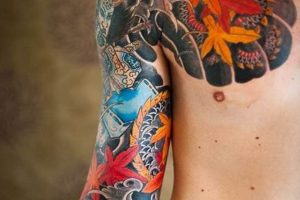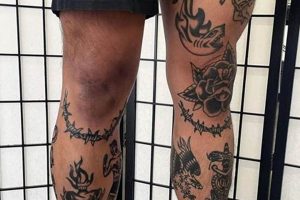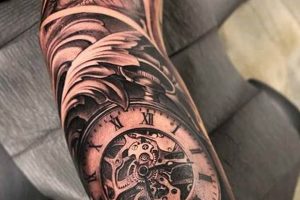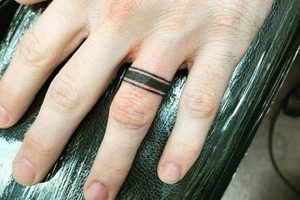Tattoos honoring mothers are a popular choice, offering men a permanent way to express love and appreciation. These designs range from simple script with her name or a significant date to elaborate portraits, often incorporating symbolic elements like flowers, hearts, or religious iconography. A classic example might feature a mother and child silhouette combined with a birth flower.
Permanent body art provides a powerful medium for conveying deeply personal sentiments. For men, a tattoo dedicated to a mother can serve as a lasting tribute, a reminder of her influence, or a memorial. Historically, maternal figures have held significant cultural and religious symbolism, representing nurturing, strength, and unconditional love. These themes readily translate into tattoo art, allowing individuals to carry a piece of their personal history and heritage.
Exploring stylistic options, placement considerations, and symbolic representation offers deeper insight into the diverse range of designs available. Understanding these elements empowers individuals to create meaningful and personalized tributes to their mothers.
Tips for Choosing a Mother-Honoring Tattoo
Selecting a design for a permanent tribute requires careful consideration. These tips offer guidance for creating a meaningful and aesthetically pleasing tattoo.
Tip 1: Consider Symbolic Elements: Incorporating meaningful symbols can enhance the design. Birth flowers, birthstones, or shared hobbies offer personalized touches.
Tip 2: Explore Portrait Options: Realistic portraits require skilled artists. Choosing a clear, high-quality photograph is essential for successful execution.
Tip 3: Evaluate Placement Carefully: Tattoo placement impacts visibility and pain levels. Consider the size and complexity of the design when choosing a location.
Tip 4: Research Tattoo Artists: Different artists specialize in various styles. Review portfolios to find an artist whose style aligns with the desired aesthetic.
Tip 5: Reflect on Personal Style: Choose a design that reflects personal taste and complements existing tattoos, if applicable.
Tip 6: Prioritize Meaningful Quotes: If incorporating text, carefully select a quote or phrase that holds personal significance.
Tip 7: Plan for Proper Aftercare: Following proper aftercare instructions is crucial for preserving the tattoo’s quality and longevity.
Careful planning ensures a timeless and personally resonant tribute. These elements combined create a design that honors a mother’s influence meaningfully.
By considering these elements, individuals can create a permanent tribute that reflects the unique bond shared with their mothers.
1. Portraits
Portraits offer a powerful way to honor mothers within the realm of memorial tattoos. A skilled artist can capture a mother’s likeness, preserving her image in a timeless tribute. This approach allows for deep personalization, reflecting her unique features and personality. A portrait’s effectiveness hinges on the artist’s skill and the quality of the reference photograph. Choosing a clear, well-lit image is crucial for achieving a realistic and recognizable representation. Factors like pose, expression, and age in the photograph significantly influence the final result. For example, a portrait based on a graduation photo might convey a sense of accomplishment and pride, while a candid snapshot might emphasize warmth and joy. The portrait’s size and level of detail further impact the overall design.
Practical considerations for portrait tattoos include placement and style. Larger portraits offer greater detail but require more skin real estate, often favoring areas like the back, chest, or thigh. Smaller portraits can be placed on the forearm, bicep, or calf. Stylistically, realism aims for photographic accuracy, while other approaches, like black and grey or illustrative styles, offer alternative interpretations. Portraits can also be incorporated into larger compositions, combined with other elements such as flowers, quotes, or symbolic imagery, adding layers of meaning and personalization. A portrait might be framed with her favorite flowers or integrated with a quote that reflects her values, creating a deeply personal and symbolic piece.
Ultimately, portrait tattoos offer a profound way to maintain a lasting connection with a mother. Careful planning, artist selection, and image choice are essential for ensuring a successful and meaningful tribute. While challenges exist in capturing a perfect likeness, a well-executed portrait serves as a permanent reminder of a mother’s presence and influence, offering solace and enduring remembrance. This approach requires significant commitment due to the detail involved and the permanence of the medium, emphasizing the importance of thoughtful consideration throughout the design process. Considering these aspects ensures a respectful and enduring homage.
2. Names and Dates
Names and dates serve as foundational elements in memorial tattoos honoring mothers. A mother’s name, rendered in elegant script or a typeface reflecting her personality, provides a simple yet powerful tribute. Incorporating significant dates, such as birthdays, anniversaries, or dates of passing, adds another layer of personal meaning, marking milestones and commemorating shared history. This approach allows for a range of design choices, from minimalist presentations to more elaborate compositions incorporating other symbolic elements. For instance, a name might be interwoven with a floral design, or a date might be framed within a heart or infinity symbol. The choice of font, size, and placement contributes to the overall aesthetic and impact.
Practical considerations include the desired level of visibility and the available space for the tattoo. A small, discreet name placed on the wrist or inner arm offers personal significance without drawing undue attention. Larger, more prominent placements, such as the chest or back, provide ample canvas for incorporating additional details and artistic flourishes. The date format (e.g., Roman numerals, numerical representation) can also contribute to the tattoo’s stylistic direction, complementing the chosen font and other design elements. Adding a small, symbolic element like a birthstone or a charm associated with a shared memory can further personalize the design. For example, a son might choose to include a small image of a baseball if he and his mother shared a love for the sport.
Combining names and dates offers a timeless and classic approach to memorializing mothers. The simplicity of this approach allows for a focused tribute, emphasizing the enduring importance of the maternal bond. While seemingly simple, these elements carry profound emotional weight, serving as permanent reminders of love and connection. Challenges might arise in balancing simplicity with visual interest, requiring careful consideration of font, placement, and potential accompanying imagery. Ultimately, this combination provides a versatile and meaningful way to honor a mother’s legacy, tailored to individual preferences and carrying lasting personal significance.
3. Floral Motifs
Floral motifs hold significant weight in the context of tattoos honoring mothers, offering a symbolic language rich in meaning and visual appeal. Flowers, often associated with life, growth, beauty, and enduring affection, provide a fitting tribute to the nurturing role of mothers. Specific blooms carry unique connotations; roses symbolize love and passion, lilies represent purity and grace, and carnations signify devotion and remembrance. Selecting a mother’s favorite flower or a bloom associated with a shared memory imbues the tattoo with deep personal significance. For example, incorporating forget-me-nots signifies remembrance and enduring connection, while a bouquet of her wedding flowers can commemorate a joyous occasion and her role in the family. The versatility of floral designs allows for seamless integration with other elements, such as portraits, names, or quotes, further enriching the tattoo’s narrative.
Practical considerations for incorporating floral motifs include the desired level of realism, color palette, and overall size. Highly detailed, realistic depictions require a skilled artist specializing in botanical art. Simpler, stylized floral designs offer a more minimalist approach, emphasizing symbolic representation over precise botanical accuracy. Color choices further influence the tattoo’s impact: vibrant colors convey energy and vitality, while muted tones evoke a sense of serenity and reflection. The size and placement of the floral motif should complement the overall composition and the individual’s body art preferences. A single stem might delicately adorn a wrist or ankle, while a larger, more intricate floral arrangement could grace a shoulder, back, or chest. Considerations such as the flowering season of chosen blooms can add another layer of personalization, linking the tattoo to a specific time of year associated with cherished memories.
The symbolic richness and aesthetic versatility of floral motifs make them a compelling choice for tattoos honoring mothers. Careful consideration of flower type, style, color, and placement allows for a deeply personalized and meaningful tribute. However, the complexity of some floral designs necessitates careful selection of a skilled artist capable of executing the desired level of detail. Ultimately, floral elements offer a powerful means of expressing love, appreciation, and remembrance, transforming a tattoo into a lasting testament to the enduring influence of a mother.
4. Symbolic Imagery
Symbolic imagery provides a powerful language for expressing complex emotions and personal narratives within tattoo art. In the context of designs honoring mothers, symbols offer a nuanced way to represent the unique bond and enduring influence of a maternal figure. These visual metaphors can convey abstract concepts like love, strength, guidance, and remembrance, adding layers of meaning beyond literal representation.
- Religious Symbols:
Religious symbols, such as crosses, Madonna figures, or angel wings, can represent a mother’s faith and spiritual guidance. These symbols might also serve as a tribute to shared religious beliefs or evoke a sense of divine protection and blessing. For individuals with strong religious convictions, incorporating these elements can create a deeply personal and meaningful connection to their mothers and their shared faith. Choosing a specific symbol relevant to the individual’s and their mother’s shared faith strengthens this connection. For instance, a Star of David could represent shared Jewish heritage.
- Celestial Bodies:
Celestial bodies, like stars, moons, and suns, frequently represent guidance, hope, and eternity. A crescent moon might symbolize a mother’s nurturing nature, while a star could represent her enduring presence and influence. Incorporating celestial imagery can also reflect a shared interest in astronomy or evoke a sense of cosmic connection. Depicting a specific constellation meaningful to both the individual and their mother further personalizes the tribute.
- Animals:
Animals, chosen for their symbolic meanings, can represent specific qualities associated with a mother. Birds, often symbolizing freedom and spiritual transcendence, can also represent a mother’s protective nature. Lions might convey strength and courage, while butterflies symbolize transformation and rebirth. Selecting an animal that held personal significance for the mother or represents a shared memory adds a layer of emotional depth. For instance, a tattoo featuring a swallow could symbolize a mother’s adventurous spirit or commemorate a shared journey.
- Geometric Patterns:
Geometric patterns, like knots, mandalas, or spirals, can represent interconnectedness, continuity, and the cyclical nature of life. These abstract designs can also add visual interest and create a sense of balance within the overall composition. Specific geometric patterns might hold cultural or spiritual significance, further enriching the tattoo’s meaning. For example, a Celtic knot could symbolize eternal love and connection, while a mandala could represent the universe and the interconnectedness of all things.
By carefully selecting and integrating symbolic imagery, individuals can create tattoos that not only honor their mothers but also tell a deeper story about their relationship and shared experiences. These symbols act as visual shorthand, conveying profound emotions and personal narratives in a concise and evocative manner. The interplay of these symbols with other design elements, such as portraits, names, or quotes, allows for a richly layered and personalized tribute, ensuring the tattoo remains a meaningful and enduring expression of love and remembrance.
5. Quote Integration
Quote integration offers a powerful method for personalizing tattoos dedicated to mothers. Incorporating meaningful text allows individuals to express sentiments, capture shared memories, or memorialize a mother’s values and beliefs. Carefully selected quotes add depth and emotional resonance, transforming a visual tribute into a narrative expression of love and remembrance.
- Meaningful Phrases:
Short, poignant phrases, such as “Forever in my heart,” “Her spirit lives on,” or “My guiding star,” encapsulate profound emotions in a concise manner. These phrases can be incorporated into various design elements, such as framing a portrait, accompanying a floral motif, or standing alone as a minimalist tribute. The selection of typeface and script style further enhances the quote’s aesthetic impact and personal significance. For example, a flowing script might convey a sense of elegance and grace, while a bolder font could emphasize strength and resilience.
- Literary Excerpts:
Excerpts from poems, novels, or song lyrics that resonated with a mother or reflect a shared appreciation for literature offer a unique and personalized touch. Choosing a passage that embodies a mother’s values, personality, or passions creates a lasting tribute to her intellectual and emotional legacy. For instance, a line from her favorite poem or a lyric from a song that held special meaning for both individuals adds a layer of shared intimacy and remembrance. The length of the excerpt and its placement within the overall design require careful consideration to ensure readability and visual balance.
- Personal Sayings:
Incorporating a cherished saying, inside joke, or a piece of advice often repeated by a mother creates a deeply personal and intimate tribute. These unique phrases capture the essence of her personality and her individual relationship with the wearer. A phrase she commonly used, a nickname she bestowed, or a piece of wisdom she imparted serves as a permanent reminder of her voice and influence. This approach requires careful consideration of font and placement to ensure clarity and visual harmony within the overall design.
- Language Considerations:
Quotes can be incorporated in various languages, reflecting cultural heritage or personal preferences. Latin inscriptions, for instance, offer a timeless and classical feel, while quotes in a mother’s native language can honor her cultural background. However, ensuring accurate translation and understanding the cultural context of the chosen quote are essential for avoiding misinterpretations or unintended meanings. Furthermore, the chosen script and font should complement the language and overall aesthetic of the tattoo.
Integrating quotes into mom tattoos provides a powerful means of expressing love, admiration, and remembrance. Whether a simple phrase, a literary excerpt, or a personal saying, the chosen words transform the tattoo into a narrative expression of a unique and enduring bond. Careful consideration of the quote’s meaning, font, placement, and language ensures a visually appealing and emotionally resonant tribute that honors a mother’s lasting influence.
6. Placement Considerations
Tattoo placement significantly impacts the visibility, aesthetic appeal, and personal meaning of a design honoring a mother. Careful consideration of location, size, and the individual’s lifestyle ensures the chosen tribute remains appropriate and resonates with its intended message.
- Visibility and Discretion:
Placement dictates how readily a tattoo is seen. Highly visible locations, such as the hands, forearms, or neck, make a public statement, while more discreet areas, like the chest, back, or ribs, offer privacy and personal reflection. For intimate tributes, less visible placements may be preferred. Conversely, individuals seeking to openly express their devotion might opt for more prominent locations. Practical considerations, such as workplace dress codes, also influence placement decisions.
- Size and Detail:
The size and complexity of the design influence placement choices. Intricate portraits or large-scale compositions require ample space, often favoring areas like the back, chest, or thigh. Smaller, minimalist designs, such as names, dates, or small symbols, can be placed on the wrist, ankle, or behind the ear. Matching placement to size ensures the design’s integrity and visual impact. A large, detailed design placed on a small area might appear cramped or lose essential details, while a small, simple design on a large area could appear lost or insignificant.
- Pain Tolerance and Healing:
Different areas of the body vary in sensitivity to tattooing. Areas with thinner skin or closer proximity to bone, such as the ribs, ankles, or feet, tend to be more sensitive. Individuals with lower pain tolerance might opt for less sensitive areas, such as the outer arms, thighs, or back. Placement also influences healing time; areas subject to more movement or friction might heal more slowly. Considering these factors ensures a more comfortable tattooing experience and optimal healing.
- Body Shape and Composition:
An individual’s body shape and existing tattoos, if any, influence placement choices. A design should complement the body’s natural contours and flow with existing body art. Placement can enhance the visual impact of a tattoo, creating a cohesive and aesthetically pleasing composition. For example, a design might follow the curve of a muscle or integrate with an existing tattoo to create a larger, unified piece. Careful consideration of body shape ensures the design harmonizes with the individual’s physique.
Placement serves as a crucial element in the design process for mom tattoos. Thoughtful consideration of visibility, size, pain tolerance, and body composition ensures the chosen tribute effectively conveys its intended message and remains a meaningful expression of love and remembrance. Ultimately, the chosen placement contributes to the tattoo’s personal significance and long-term aesthetic appeal, reflecting the individual’s relationship with their mother and their personal style.
7. Stylistic Choices
Stylistic choices significantly influence the aesthetic and emotional impact of tattoos honoring mothers. Selecting an appropriate artistic style ensures the design effectively conveys the intended message and resonates with the individual’s personal preferences. Various styles, each with unique characteristics, offer diverse approaches to memorializing a mother’s influence.
- Realism:
Realism aims for photographic accuracy, capturing intricate details and nuanced shading. This style excels in portrait tattoos, reproducing a mother’s likeness with striking precision. However, realism demands a highly skilled artist and meticulous execution. The level of detail requires larger canvases, often making realism more suitable for larger-scale tattoos. Examples include highly detailed portraits of mothers, often combined with realistic depictions of flowers or other symbolic elements. This style prioritizes accuracy and visual fidelity, creating a lifelike representation of cherished memories and personal connections.
- Traditional:
Traditional, or American Traditional, tattoos feature bold lines, vibrant colors, and iconic imagery. This style often incorporates symbolic elements like roses, anchors, and hearts, lending itself well to designs honoring mothers. Traditional tattoos possess a timeless quality and age well due to their bold lines. Examples include classic mom tattoos with banners, hearts, and flowers, often incorporating a mother’s name or a significant date. This style emphasizes symbolic representation and bold visual statements, creating a lasting tribute with a vintage aesthetic.
- Watercolor:
Watercolor tattoos mimic the fluidity and vibrancy of watercolor paintings. This style offers a softer, more artistic approach, often incorporating splashes of color and abstract elements. Watercolor tattoos can create a dreamlike or ethereal quality, particularly suited for expressing emotional depth and personal connection. Examples include floral designs with flowing colors or abstract representations of a mother’s spirit or energy. This style prioritizes artistic expression and emotional resonance, creating a visually captivating and deeply personal tribute.
- Minimalism:
Minimalism emphasizes simplicity and clean lines. This style often features small, geometric shapes, fine linework, and limited color palettes. Minimalist tattoos offer a subtle yet impactful way to honor a mother, focusing on essential elements and symbolic representation. Examples include small outlines of hearts, infinity symbols, or a mother’s name rendered in a delicate script. This style prioritizes understated elegance and symbolic meaning, creating a discreet yet powerful tribute.
Careful consideration of stylistic choices ensures the chosen tattoo effectively reflects both the individual’s personal aesthetic and the unique qualities of the maternal bond. Selecting a style that resonates with the intended message and complements the chosen imagery and placement creates a lasting tribute that honors a mother’s influence meaningfully and aesthetically. Ultimately, the chosen style contributes to the tattoo’s emotional resonance and long-term visual appeal.
Frequently Asked Questions
This section addresses common inquiries regarding tattoos honoring mothers, offering practical guidance and clarifying potential concerns.
Question 1: What are some appropriate symbols to include in a mom tattoo?
Appropriate symbols vary based on individual relationships and cultural backgrounds. Common choices include birth flowers, hearts, infinity symbols, religious icons, or animals representing shared interests or personality traits. Meaningful symbols add layers of personalization and emotional depth.
Question 2: Where is the best placement for a mom tattoo?
Optimal placement depends on desired visibility, design size, and pain tolerance. The chest, back, and forearms offer larger canvases for detailed designs, while the wrist, ankle, or behind the ear provide discreet locations for smaller tributes. Placement should complement the design and the individual’s physique.
Question 3: How much does a mom tattoo typically cost?
Tattoo costs depend on factors like size, complexity, artist experience, and studio location. Small, simple designs might cost less, while larger, more intricate pieces require greater investment. Consulting with reputable artists provides accurate cost estimates based on individual design specifications.
Question 4: How should one choose a reputable tattoo artist?
Thorough research is crucial for selecting a reputable artist. Reviewing portfolios, checking studio hygiene standards, and seeking recommendations help ensure quality artistry and safe practices. An artist’s specialization should align with the desired style and design elements.
Question 5: What is the typical healing time for a tattoo?
Tattoo healing generally takes two to three weeks. Proper aftercare, including regular cleaning and moisturizing, is essential for optimal healing and preventing complications. Following artist instructions minimizes risks and ensures the tattoo’s longevity.
Question 6: Can a mom tattoo be modified or covered up later?
Modifications and cover-ups are possible, but depend on the original design’s size, color, and placement. Consultations with experienced artists determine feasibility and discuss design options. Cover-ups might require larger and more complex designs to effectively conceal the original tattoo.
Careful consideration of design, placement, artist selection, and aftercare practices ensures a meaningful and lasting tribute honoring a mother’s enduring influence. Addressing these common questions empowers informed decision-making throughout the tattoo process.
Further exploration of specific design elements and stylistic choices offers additional guidance for creating a personalized and meaningful tribute.
Conclusion
Exploring permanent body art dedicated to mothers reveals a diverse range of options for meaningful expression. Considerations of symbolic imagery, stylistic preferences, and placement options allow individuals to create deeply personal tributes. From classic portraits and floral motifs to abstract symbols and integrated quotes, design choices reflect the unique bond between mothers and their sons. Practical considerations, such as artist selection, cost, and aftercare, ensure the chosen design remains a lasting and aesthetically pleasing homage.
A thoughtfully designed tattoo serves as a powerful reminder of a mother’s enduring influence. The permanence of the medium underscores the depth of this connection, offering a timeless tribute that transcends generations. Ultimately, the most impactful designs emerge from careful reflection on personal experiences and a commitment to honoring the unique qualities of the maternal bond.







